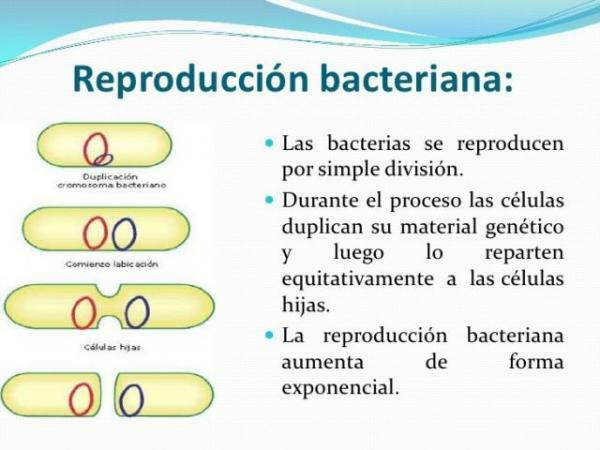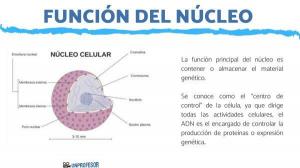Discover how BACTERIA REPRODUCES

Image: 100Cia
Like the rest of the living beings, bacteria have the ability to reproduce. The reproduction of bacteria is very particular since, in general, it occurs through asexual reproduction, that is, there is no exchange of DNA between two different bacteria. On certain occasions, two different bacteria can exchange genetic material through transformation, transduction or conjugation. If you want to know how bacteria reproduce, when and how asexual reproduction takes place and how the different types of DNA exchange between bacteria take place, we encourage you to continue reading this lesson from a TEACHER!
Bacteria normally reproduce by means of binary fission or bipartition. This process is intended to create two daughter cells, same as the starting cell or stem cell. That is, we are cloning the original starting cell. Only one cell is involved in this process, so there is no exchange of genetic material: it is a type of asexual reproduction.
The stem cell is nurtured through different methods, growing and growing. When the cell is too large to continue to function efficiently, that is, the surface-to-size ratio is too small, the cell is forced to reproduce. At that point, the cell begins the bipartition process. First,
the cell duplicates its genetic material, What can be Single-stranded and circular DNA. The two DNA molecules remain loosely attached to each other and to a nearby region of the plasma membrane since bacteria are prokaryotic organisms (without a nucleus or nuclear envelope).The genetic material of bacteria
To know how bacteria reproduce, you have to know that, in certain cases, bacteria also have complementary genetic material. This genetic information also has to be copied since, although it is not essential for their survival, it gives them advantages over other bacteria that do not have it. This additional genetic material is called plasmid, and the same bacterium can have more than one type of plasmid or more than one copy of the same plasmid.
Plasmids can make a bacterium produces an antibiotic that attacks another bacterium but not her, or on the contrary, it can make it resistant to an antibiotic, natural or man-made. This is how antibiotic resistant bacteria appear, but plasmids are also very useful in research, vaccine creation, etc.
Growth of the plasma membrane
Once the genetic material of the bacterium has been copied, the cell has to duplicate other components that are basic to create another cell. Being prokaryotic, bacteria need make your plasma membrane bigger, so they create fundamental components of the membrane: lipids and proteins. These molecules are incorporated into the region between the two junction points of the DNA molecules, causing them to separate.
When the plasma membrane has grown sufficiently, a fold or invagination occurs on each side of the membrane, getting closer and closer together. Finally, the invaginations of the plasma membrane touch in the center, unite, and the cytoplasm is divided in two. This process of division of the cytoplasm is called cytokinesis. At the same time, on the outside of the plasma membrane in formation, substances are deposited that form the bacterial cell wall. Depending on where the division of the cytoplasm occurs, the bipartition can be of different types: regular, longitudinal, amoeba type, flagellate type, etc.
With this type of reproduction, very fast and efficient, bacteria succeed in creating colonies of millions of organisms in minutes. In addition, due to the high rate of errors bacteria make when duplicating their DNA, many mutations, which make the individuals of a bacterial colony not exact clones of each other. This gives them many advantages when it comes to surviving since it generates diversity and the ability to adapt to environmental changes, including the appearance of antibiotics.
Sometimes bacteria can exchange genetic material with each other. In this case we are facing a parasexual reproduction strictly speaking, not of sexual reproduction since, although it is an exchange of genetic information, it does not involve the creation of gametes, their fusion or the appearance of a zygote. There are three mechanisms that tell us how bacteria reproduce in a parasexual way: transformation, transduction and conjugation.
By means of the transformationCells are capable of incorporating more or less small DNA fragments that are in the environment that surrounds them; This genetic material comes almost entirely from bacteria whose plasma membrane has been broken (they have lysed) and all their cellular content has gone outside. Many authors doubt that this process occurs naturally but it has been studied and used for decades in research and industrial studies.
The second mechanism of parasexual reproduction is transduction. In this process a bacteriophage, which are viruses that infect bacteria and use them to create more copies of themselves. Bacteriophages signal the bacteria to create copies of their DNA. While copying it, the bacterium introduces copies of its own DNA into it so that, when that bacteriophage infects another bacterium, it will take the bacterial DNA fragment with it. The second bacterium, upon receiving it, can cut that piece of DNA, make copies and keep some for itself.
The ultimate parasexual reproductive mechanism is conjugation. Conjugation occurs when there is a special type of plasmid called plasmid F. This plasmid carries genetic information that allows it to form a pili. Pili are cylindrical structures that act as a bridge between two bacteria and allow them to exchange plasmids. In this way, a bacterium with plasmid F (F +) connects with another that does not have it (F-), and donates one or more of its plasmid copies, including plasmid F. This bacterium, before F-, becomes F + and has all the plasmids that the first one passed to it. Once the exchange is finished, the pili disappears, the bacteria are no longer connected and now both can exchange DNA with other F- bacteria.



